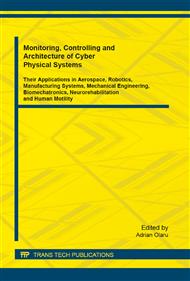p.43
p.53
p.64
p.72
p.81
p.95
p.101
p.110
p.121
Modeling and Simulation of the Gas Absorption Process in the Liquid Phase
Abstract:
In this paper, a solution for the modeling and simulation of the gas absorption process in a liquid is presented. In the modeling procedure, the technological process is decomposed in two sub-processes connected in series, the first sub-process being considered a lumped parameter one, respectively the second sub-process being considered a distributed parameter one. In order to simulate, with a high accuracy, a process that includes in its structure a distributed parameter sub-process, an original method based on the matrix of partial derivatives of the state vector, associated with Taylor series, is used. The modeling-simulation procedure introduces the premise to approximate the concentration value of the gas absorbed in liquid, in relation to the initial pressure from the reactor, respectively the premise of including the technological process in a concentration control structure.
Info:
Periodical:
Pages:
81-94
Citation:
Online since:
October 2014
Price:
Сopyright:
© 2014 Trans Tech Publications Ltd. All Rights Reserved
Share:
Citation:


